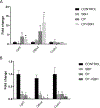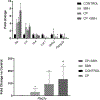Intestinal inflammation marker calprotectin regulates epithelial intestinal zinc metabolism and proliferation in mouse jejunal organoids
- PMID: 38593708
- PMCID: PMC11913417
- DOI: 10.1016/j.biopha.2024.116555
Intestinal inflammation marker calprotectin regulates epithelial intestinal zinc metabolism and proliferation in mouse jejunal organoids
Abstract
Calprotectin (CP), a heterodimer of S100A8 and S100A9, is expressed by neutrophils and a number of innate immune cells and is used widely as a marker of inflammation, particularly intestinal inflammation. CP is a ligand for toll-like receptor 4 (TLR4) and the receptor for advanced glycation end products (RAGE). In addition, CP can act as a microbial modulatory agent via a mechanism termed nutritional immunity, depending on metal binding, most notably Zn2+. The effects on the intestinal epithelium are largely unknown. In this study we aimed to characterize the effect of calprotectin on mouse jejunal organoids as a model epithelium, focusing on Zn2+ metabolism and cell proliferation. CP addition upregulated the expression of the Zn2+ absorptive transporter Slc39a4 and of methallothionein Mt1 in a Zn2+-sensitive manner, while downregulating the expression of the Zn2+ exporter Slc30a2 and of methallothionein 2 (Mt2). These effects were greatly attenuated with a CP variant lacking the metal binding capacity. Globally, these observations indicate adaptation to low Zn2+ levels. CP had antiproliferative effects and reduced the expression of proliferative and stemness genes in jejunal organoids, effects that were largely independent of Zn2+ chelation. In addition, CP induced apoptosis modestly and modulated antimicrobial gene expression. CP had no effect on epithelial differentiation. Overall, CP exerts modulatory effects in murine jejunal organoids that are in part related to Zn2+ sequestration and partially reproduced in vivo, supporting the validity of mouse jejunal organoids as a model for mouse epithelium.
Keywords: Calprotectin; Intestinal epithelium; Intestinal inflammation markers; Organoid; Proliferation; Zinc.
Copyright © 2024 The Authors. Published by Elsevier Masson SAS.. All rights reserved.
Conflict of interest statement
Declaration of Competing Interest The authors declare that they have no known competing financial interests
Figures













Similar articles
-
Calprotectin: The Link Between Acute Lung Injury and Gastrointestinal Injury in Covid-19: Ban or Boon.Curr Protein Pept Sci. 2022;23(5):310-320. doi: 10.2174/1389203723666220610124303. Curr Protein Pept Sci. 2022. PMID: 35692161
-
Chronic alcohol administration causes expression of calprotectin and RAGE altering the distribution of zinc ions in mouse testis.Syst Biol Reprod Med. 2015 Jan;61(1):18-25. doi: 10.3109/19396368.2014.949905. Epub 2014 Aug 20. Syst Biol Reprod Med. 2015. PMID: 25140408
-
Zinc sequestration by the neutrophil protein calprotectin enhances Salmonella growth in the inflamed gut.Cell Host Microbe. 2012 Mar 15;11(3):227-39. doi: 10.1016/j.chom.2012.01.017. Cell Host Microbe. 2012. PMID: 22423963 Free PMC article.
-
A Structural Perspective on Calprotectin as a Ligand of Receptors Mediating Inflammation and Potential Drug Target.Biomolecules. 2022 Mar 30;12(4):519. doi: 10.3390/biom12040519. Biomolecules. 2022. PMID: 35454108 Free PMC article. Review.
-
Calprotectin - a pleiotropic molecule in acute and chronic inflammation.Physiol Res. 2004;53(3):245-53. Physiol Res. 2004. PMID: 15209531 Review.
Cited by
-
The Role of Calprotectin in the Diagnosis and Treatment of Inflammatory Bowel Disease.Int J Mol Sci. 2025 Feb 25;26(5):1996. doi: 10.3390/ijms26051996. Int J Mol Sci. 2025. PMID: 40076618 Free PMC article. Review.
References
MeSH terms
Substances
Grants and funding
LinkOut - more resources
Full Text Sources
Miscellaneous

